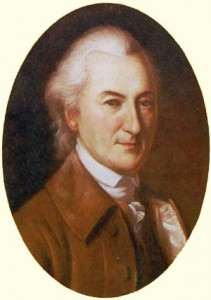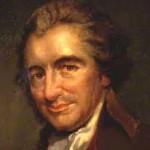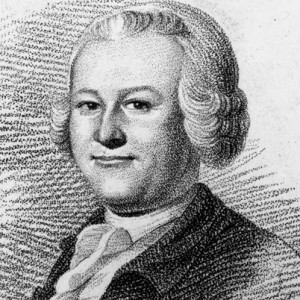The celebration of American Independence Day on the Fourth of July has come to include parades, barbecues and fireworks. The celebrations should include discussions of how the Declaration of Independence came to be. In Part One. The Committee of Five appointed to draft a declaration of independence had dwindled in reality to just Thomas Jefferson and John Adams. In Part Two, Jefferson and Adams agree to the declaration’s form. Part Three explores Jefferson’s state of mind following his meeting with Adams, with Jefferson wishing he were in Virginia. In Part Four, Jefferson’s selection to draft the declaration takes place. In Part Five, Jefferson considers the lessons of history as he begins work on the Declaration. In Part Six, Jefferson finds his mission: to express the American Mind and give definition to distinctly American principles of governance.
Thomas Jefferson had begun his preparation to draft the announcement that America was in revolt against England by recalling historical announcements of revolution. It was clear that for the world audience to understand Jefferson would need to list the king’s crimes and how by those crimes the king no longer had the right to rule. Those ideas would be understood by international readers of the declaration and allow them to support the revolution, since it would no longer be a civil war within the British Empire, but a war between two sovereign nations.
There was another, more important audience: the American people. For that audience, the declaration had an entirely different task. For the American people, the declaration did not have to educate or convince, but rather to express on their behalf what they already felt and believed.
Tracing the Development of The American Mind
Jefferson had come of age as America was developing a mind of its own. Attorney James Otis’ 1760 court arguments opposing British searches of colonial property in the Writs of Assistance cases had become well known. Otis had advanced the principle that there was a higher law that governed governments as well as people. Otis’ arguments contained the seeds of what had now become the prevailing thought in America. Otis’ pamphlet of 1762, A Vindication of the Conduct of the House of Representatives relied abundantly on John Locke’s Second Treatise of Government and its principles of natural law.
Otis argued natural law was above the law of the “unwritten” British constitution. Otis was a messenger for freedom, though Vindication was sprinkled with compliments for the king. While Vindication had compliments for King George, Otis’ also asserted that the people possessed a “right of revolution”. In asserting a right of revolution Otis brought John Locke’s philosophy to the attention of the colonists and over the next sixteen years Americans had made Locke’s ideas of a sovereign individual consenting to a limited government their own.
During these past sixteen years Jefferson had not only studied Otis and Locke, he had been a participant in events and made his own contributions to the American Mind. Jefferson’s treatise, A Summary View of the Rights of British North America, had been one contribution. His education and experience helped him to recognize the sense of the American people that the declaration would need to express. American thought on British rule had evolved over time, with many contributors to that evolution.
 John Dickinson, although he seemed a current political stumbling block to independence, had contributed. Dickinson’s series of twelve essays, Letters from a Farmer in Pennsylvania, published in 1767-68, questioned British authority and hinted at armed conflict. The essays had brought Dickinson fame and respect. Using points from those essays would contribute to the success of Jefferson’s draft declaration. Dickinson and those who respected him were an important part of the declaration’s intended audience.
John Dickinson, although he seemed a current political stumbling block to independence, had contributed. Dickinson’s series of twelve essays, Letters from a Farmer in Pennsylvania, published in 1767-68, questioned British authority and hinted at armed conflict. The essays had brought Dickinson fame and respect. Using points from those essays would contribute to the success of Jefferson’s draft declaration. Dickinson and those who respected him were an important part of the declaration’s intended audience.
Jefferson made notes of other influences on the American Mind. The notes showed the development of American thinking. Jefferson started with James Otis and his own experiences in the Virginia legislature. From the fiery oratory of fellow Virginian Patrick Henry, to the many newspaper essays and pamphlets in circulation, the evidence of how Americans thought about government, and their growing restlessness under British rule was everywhere. There were two pieces of evidence that were recent and influential.
 Jefferson considered how the hugely popular pamphlet by Thomas Paine, Common Sense, both reflected and educated its readers. Paine had written what hundreds of thousands of Americans were thinking, and sold hundreds of thousands of pamphlets. Paine’s readers had their thoughts confirmed and gained the tools they needed to arouse or inspire others. Providing further tools would be part of the declaration’s purpose.
Jefferson considered how the hugely popular pamphlet by Thomas Paine, Common Sense, both reflected and educated its readers. Paine had written what hundreds of thousands of Americans were thinking, and sold hundreds of thousands of pamphlets. Paine’s readers had their thoughts confirmed and gained the tools they needed to arouse or inspire others. Providing further tools would be part of the declaration’s purpose.
Then, just yesterday, the Pennsylvania Gazette’s June 12, 1776 edition published an item that reminded Jefferson why he wished he were in Virginia. George Mason and a committee of the Virginia Convention had created Virginia’s Declaration of Rights as part of the process involved in designing the state’s constitution. The Gazette had published a proposed draft of Virginia’s Declaration. It contained elements of the developed American Mind and began:
Virginia Declaration of Rights
I That all men are by nature equally free and independent, and have certain inherent rights, of which, when they enter into a state of society, they cannot, by any compact, deprive or divest their posterity; namely, the enjoyment of life and liberty, with the means of acquiring and possessing property, and pursuing and obtaining happiness and safety.
II That all power is vested in, and consequently derived from, the people; that magistrates are their trustees and servants, and at all times amenable to them.
III That government is, or ought to be, instituted for the common benefit, protection, and security of the people, nation or community; of all the various modes and forms of government that is best, which is capable of producing the greatest degree of happiness and safety and is most effectually secured against the danger of maladministration; and that, whenever any government shall be found inadequate or contrary to these purposes, a majority of the community hath an indubitable, unalienable, and indefeasible right to reform, alter or abolish it, in such manner as shall be judged most conducive to the public weal.
Jefferson recognized that The Virginia Declaration of Rights expressed many principles that had become part of the uniquely American concept of government. The Virginia Declaration began with a belief in the equality of men and that all men possessed rights that no government could take away, nor could any man give away these rights. The next American principle Virginia’s Declaration announces is that government officials are the servants of the people and serve with the people’s consent. Virginia, in Part III, also recognizes that the people possess a most critical right in the event that government interferes with the exercise of the people’s inherent rights or its officials fail to serve the people: The Right of Revolution.
The End of a Long Day
He had agreed upon an outline with John Adams of the declaration to explain to the world the reasons for American independence. Having completed his notes on the evolution and current state of, as he called it, the American Mind, putting meat on the skeleton of the outline would be Jefferson’s next challenge. That would need to wait until tomorrow. He picked up his violin to clear his mind so that he might sleep.
The final installment of this series is: Birthing of the Declaration of Independence: Part Seven, Quill is Set to Parchment
This series has become the basis for the Book: Creating the Declaration of Independence
Available on Amazon in print and Kindle editions.






